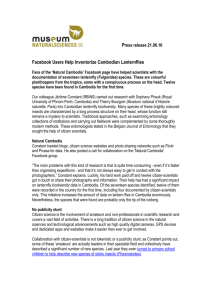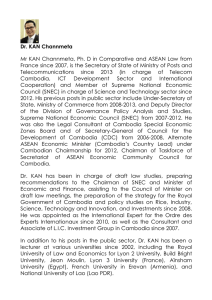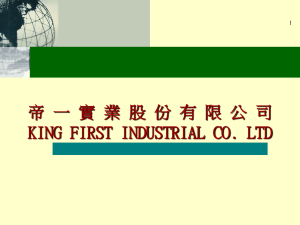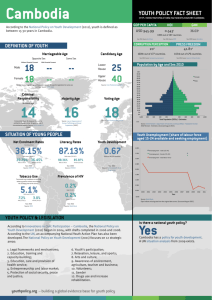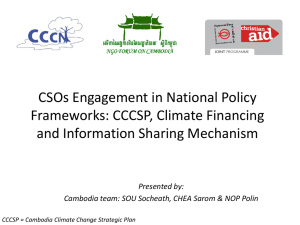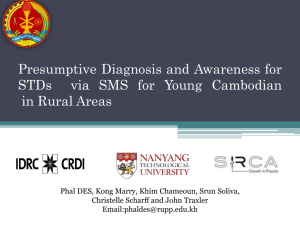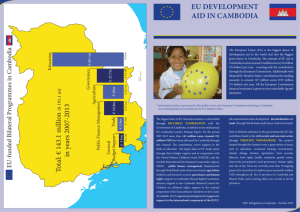National Strategic Plan on Green Growth 2013-2030
advertisement
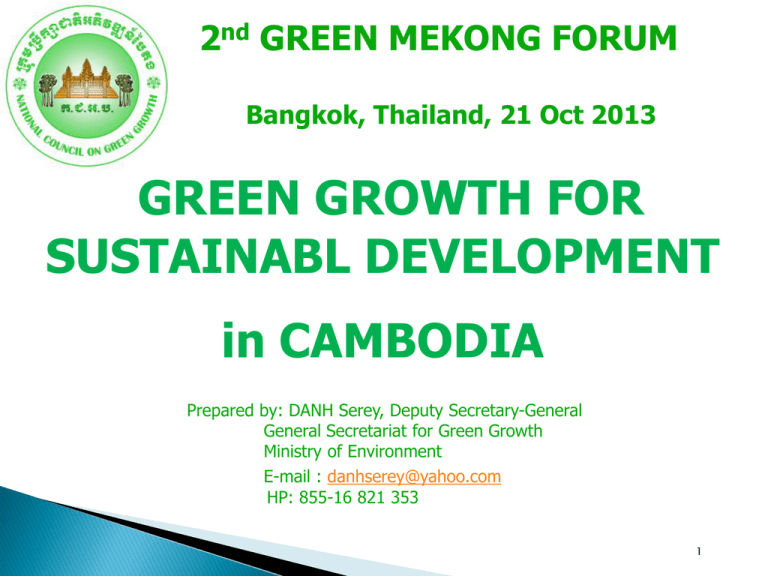
2nd GREEN MEKONG FORUM Bangkok, Thailand, 21 Oct 2013 GREEN GROWTH FOR SUSTAINABL DEVELOPMENT in CAMBODIA Prepared by: DANH Serey, Deputy Secretary-General General Secretariat for Green Growth Ministry of Environment E-mail : danhserey@yahoo.com HP: 855-16 821 353 1 Climate Change issue refers to a global warming, increase in temperature, heat wave, drought, sea level rise, increase in salinity, shortage of fresh water, icy melting, flood, arid soil, soil degradation, worn-out of soil fertilizer. Human activities and natural disasters posing major concerns and challenges, such as insecurity of food, energy, economic and financial, social instability and a loss of ecological balance for both the developed and developing countries, as well as the whole world. Excessive potential use of natural resources, the growing population, and industrial growth also exerts strong pressure on environment that causes imbalance between economic growth, and natural resources conservation, especially biodiversity, forest, fishery, water resource, mines, and land. To solve these problems, Cambodia established many environmental legal frameworks and policies particularly green growth policy for ensure sustainable development. A- Laws and Regulations Constitution Law 1993 Law on Environmental Protection and Natural Resources Management, 1996 Law on Protected Area Management, 2008 Law on Biosafety, 2008 Sub-decree on EIA Process, 1999 Cambodia ratified the UNFCCC , 1995 and the Kyoto Protocol , 2002. Global Green Growth Institute Agreement, 2012 Mekong Agreement, 1995 B- Policies Rectangular Strategy Phase III, 2013-2018 National Policy on Green Growth, 2013 National Strategy Plan on Green Growth 2013-2030 Rectangular I: Promotion of Agriculture Sector Side 4: Sustainable Management of Natural Resources Base on this rectangular, the RGC will place priority on: Stepping up cooperation with relevant development stakeholders under the framework of the “National Policy on Green Growth” and the “National Strategic Plan on Green Growth 2013-2030” through the development of regulatory frameworks and mechanisms for carbon trading strengthening the capacity, preparation and implementation of climate change adaptation measures, assessment of the scope of the use of environmental financing mechanisms including payment for environmental service and environmental fund, strengthening the management of protected areas including protection of biodiversity, rain forest, and wetland areas; and environment and ecosystem monitoring and control mechanism at both national and sub-national levels. Climate change from mitigation to adaptation measures is part of Cambodian green growth focusing on the coherent and balanced integration of economic, environmental, social and cultural dimensions into the overall national development plan and processes. Climate change is to achieve green growth goals, i.e. low carbon growth and development resilient to climate change. The Royal Government of Cambodia has placed a top priority on green growth with environmental sustainability as the core for the achievement of Cambodia Millennium Development Goals (MDGs) and poverty reduction. Green Growth Institutions have been established: National Council on Green Growth (NCGG); General Secretariat for Green Growth (GSGG) in 2012. NCGG GSGG Division of Administration and Finance Division of Green Environment and Natural Resources Division of Green Economy and Investment Division of Evaluation and Monitoring Green Growth Road Map focuses on: 1. Access to Water Resource Management and Sanitation 2. Access to Food Security (Agriculture) and non-chemical products; 3. Access to sustainable land-use 4. Access to Renewable Energy and Energy Efficiency 5. Access to Information and Knowledge 6. Access to Means for Better Mobility 7. Access to Finance and Investments All of these have been integrated into the national green growth policy and strategy. . The National Policy on Green Growth was approved by RGC on 1 March 2013. The policy is envisaged to strike balance of economic development with environment, society, culture and sustainable use of national resources through integration, matching and adaptation, as well as harmonization between a green growth principle and national policy. The policy aims at enhancing the well-being and livelihood of all people in harmonization with ecological safety through green growth, basing on green economy, blue economy, environment protection, social safety nets system and uphold of national cultural identity. In order to achieve the GG goals,main strategies are as follows: 1-International and National Collaboration and Coordination 5-Sustainable Green Technology Development 2-Study, Research and Data Analysis GREEN GROWTH GOALS 4- Human Resources Development 3-Harmonization of Green Growth in the Economy, Society, and Culture National Strategy Plan on Green Growth 20132030 was adopted by RGC on 1 March 2013. The strategy needs to improve green growth by focusing strategic direction includes: 1-Green Investment and Green Jobs Creation 2-Green Economy Management in balance with Environment 3-Blue Economy Development with Sustainability 4-Green Environment and Natural Resources Management 5-Human Resources Development and Green Education 6-Effective Green Technology Management 7-Promotion of a Green Social Safety System 8-Uphold and Protection of Green Cultural Heritage and National Identity 9-Good Governance on Green Growth (i). Green Investment and Green Jobs Creation (ii). Green Economy Management in balance with Environment (iii). Blue Economy Development with Sustainability Encourage investors to take green growth into account and create jobs with green technology use. Investment in Efficient Use of Natural Resources Effective Management of Finance in the Public and Private Sectors Green Fiscal Management Management of Green Monetary Policy Management of Payment for Environmental Services Effective Revenue-Expenditure Management Blue Economy Management and Development Monitoring on Marine Pollutants Ensuring Marine Food Security Reducing Greenhouse Gas Emission and Climate Change Adaptation (iv). Green Environment and Natural Resources Management (v). Human Resources Development and Green Education (vi). Effective Green Technology Management Green Agriculture, Food Security, Food Safety and Hygiene Sustainable Water Resources Management Effective Management of Energy and Renewable Energy Management and Sustainable Land Usage Conservation and Sustainable Fishery Management Infrastructure Development and Green Transports Green Tourism Development Environmental Quality Improvement Promoting Green Growth in a Formal Systematic Education Promoting Green Growth in a NonSystematic Education Exchanging green knowledge, experience and technology Dissemination and Education through Media Equipping Green Technology Training on Green Technology Green technology Investment (vii). Promotion of a Green Social Safety System (viii). Uphold and Protection of Green Cultural Heritage and National Identity (ix). Good Governance on Green Growth Green Culture Social Safety Social Protection Uphold and Protection of Green Culture Green Cultural Heritage Conservation Enhancement of Intangible Cultural Heritage Promote cooperation on good governance between national and international green institutions Preparing legal framework and policy Human Capacity Building Mobilize finance and development funds Enhancing Transparence, Accountability, and Responsibility 1. Intergrade green growth principles into NSDP 2014-2018. 2. Capacity Building on Green Growth 3. Develop the Green Growth Law 4. Technical and financial supports for apply the priority projects as mentioned in the annex of the national strategic plan 2013-2030

